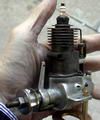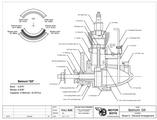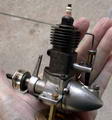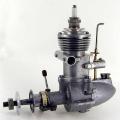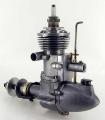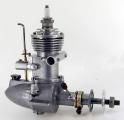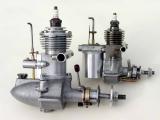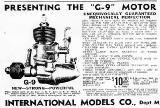| Name | IMP G9 | Designer | International Motors |
| Bore | 7/8" (21.44mm) | Stroke | 15/16" (23.81mm) |
| Type | Spark Ignition | Capacity | 0.564cuin (9.247cc) |
| Production run | unknown | Country of Origin | USA |
| Photo by | Ken Croft | Year of manufacture | circa 1939 |
Background
This one is almost good enough to be a Watzit. The engine was first advertised in 1939 by "International Models [Products]" of New York as the "G9". The ads quoted a bore of 7/8" and stroke of 15/16". Later, the manufacturer seems to have moved to Boston, changed their name to "Belmont Miniature Motors" and the engine became known simply as the Belmont. No ad we've been able to trace ever stated the capacity, only the bore and stroke, although Model Airplane News in their annual gas engine round-up for 1940 and 1941 quote the calculated capacity. The engine had disappeared from sale by 1942, precisely when, we don't know. Based on photos accompanying the various advertisements, it appears the G9 had a cast, streamlined tank, while the "Belmont" had a cylindrical tank secured under the venturi tube, per common practice.
Two cylinder types are apparent. One, seen in the photos at the head of this page, features a solid cast-iron cylinder with a honeycomb of drilled passages forming the transfer passages. One of these which would otherwise open the whole system to the atmosphere, is closed off by the simple expedient of pressing in a .177 cal BB pellet! The second variety, seen below cuts the transfers into the rear face of the C-I cylinder, closing them off with an aluminum plate which carries the venturi. This arrangement required lugs to be cast into the sides of the cylinder to attach the plate—a simple enough mod to the original pattern, so it's reasonable to conclude this represents a later version. At the same time, the cross-drilled, cast-in exhaust was replaced by a bolt-on tube, surther simplifying manufacturing steps on the cylinder.
Today, it is a very, very rare bird. The engine pictured here is a restoration job completed by Ken Croft from a basket-case. It would appear to be a "G9", having the cast, streamlined tank, but while the transfer/inlet detail is about right, it's gained a tubular exhaust (like the Gnat) and something strange has happened to the head. All pictures in the ads show a one piece (blind-bored) head, while Ken's is secured by a rather dodgy set-up suggesting modifications by an earlier owner. But the best is yet to come; Ken's cylinder bore is not and never could be 7/8" as quoted by the ads. This has left us rather perplexed. Here's the story, gathered from emails as it unfolded; first Ken:
I thought you all might be interested in what is probably the rarest engine I have yet worked on. This is marked inside the rear cover/tank as an Imp, although it is not identical to either the engine shown in the Imp adverts as a G9, or in the Belmont adverts as a "Belmont". Whatever it was originally sold as there is no doubt that it was designed by and probably made by Belmont, as it is a very similar design to the smaller Belmont Gnat.
When it came to me it was a hopeless mess of broken lugs and incomplete welding. There is no doubt that it had been got-at before it came to me, and I suspect that even some of the damaged parts that I had to replace, were not original parts. The other odd thing is that all the ads and data that can be found for this engine state that it is 7/8" bore and 15/16" stroke, and 9cc. Actually this calculates out as 9.23 cc but near enough to the stated 9cc. Strangely the engine I have just restored is only 3/4" bore and 15/16" stroke, making it only 5.9cc (but see addendum below! rc). This cannot possibly have been a modification that somebody has carried out, as the liner is very thin, and even the OD of the liner is not as big as 7/8". So its all very odd.
And here it is running. The real weakness of the engine is the problem of the head gasket. The head bolts down with 4 tiny screws through a very thin top fin which just bends. I have managed to get a trapped gasket to hold, and It will probably need to be a soft aluminum one. I had trouble getting it do run at all properly on the recommended 13x7, but when I worked out that this engine is actually 5.9cc and not 9.3 as per the actual G9, I changed to a Top Flite 12x4 and got much better runs.
Mechanically the only problem is that the cylinder is those 4 tiny screws with a very thin top fin and plate-nuts underneath. The fin bends and is in danger of breaking. The only thing that makes it seal at all is that the top of the liner is 30 thou proud of the top face of the casting, and fits into a recess in the head. This allows a trapped gasket to be fitted, and that is what it now has. That gasket should really be annealed aluminum, and although I have some, I do not think the little bolts could exert enough pressure to make the gasket seal. I could fit a complete steel split ring under the top fin, and fit eight little screws instead of four. I am sure that would work, but this is an old engine that has been restored, not an engine up for performance enhancement, and we want to keep it looking as near to original as our limited knowledge allows.
Cheers
ken
Now, to demonstrate once again that it never pays to rush into print before all the facts are adequately researched, a week after the above info was received, the Motor Boys had done some more archaeology. First Ken has to revise the capacity upwards by almost a cc, and comes up with a plausible explanation for the "G9" designation that has nothing whatsoever to do with the engine capacity:
Firstly, please revise the stuff I sent you so that wherever I say the engine is 5.9cc, it reads 6.79cc. I simply did the sums wrong!
Mike Beach and myself have been talking a lot about the Imp G9 [or the Belmont]. In particular, Mike does not believe that the "9" meant 9cc, since you folks across the pond always used cubic inches, not cc's. Hence the 9 would not have had much meaning. Furthermore, we have not seen in any advert, a reference to the engine capacity, other than the bore and stroke. We each have a theory.
So here is my theory: The engine I worked on had an upper cylinder casting that could not possibly be made to have a 7/8" bore liner inserted, the bore that all the adverts claim for the engine. The 3/4" bore of my engine was the max that could be accommodated, and the engine is actually 6.79cc (0.414cuin). I believe that the G9 and the Belmont were possibly always 6.79cc, but that buyers assumed from the G9 and the stated bore and stroke, that they were 9.24cc. As a result, owners expected 9.24cc performance, but achieved only 6.79cc performance and were not pleased. This would lead to poor sales and a rare engine as a result. I believe that the advertised 7000rpm on a 13" prop was a mistake [or a fib]. I would hazard a guess that if any more of these engines exist in the hands of collectors, they all turn out to be 3/4" bore and hence 6.79cc. The only other possibility is that this was originally designed as a "slag" engine without a liner, but when it eventually went into production it was fitted with a liner and the makers forgot to change the adverts. A bit bizarre I know, but how else do you explain away an engine that everybody believes is 9cc but if fitted with a cylinder liner, could never have been so?
Now here is Mike's theory: Mike remembers that there was a pulp magazine in the USA called "G8 and his Battle Aces" and it was all about WW1 aviators. Mike also has seen somewhere on an advert for the G9, something like "designed and built by wartime aviators". Putting two and two together, and possibly making five, Mike believes that the G9 engine was like the next thing after the G8 [of the Battle Aces].
Any comments?
Bert Striegler now looked in Model Airplane News for 1939, when the ads for the G9 and the smaller "Gnat" first appeared and believes there may be yet another AHC connection. Bert:
I found several listings of the Belmont/Imp G-9 and Bennett, which seem to be variations of the same engine. In all cases they list the bore at 7/8" and the stroke at 15/16". If the bore was 7/8 with a 15/16 stroke, that would indeed be .564 cubic inches per my calculations, but any bore less than that, 3/4" per Ken, would of course lead to a smaller displacement of .414 cu. in. (if the stroke was kept at 15/16) or around 7cc. AHC seems to have been the sponsor of them. There is a heck of a lot that is not known about these engines, including the little Gnat that Ken and I built. Fortunately, we had an original engine to go by and an original crankcase casting for each of us to work with, but it is different in some details from the ones usually pictured, so there must have been at least two versions. There were also several versions of the larger engine, for instance, one with the bullet tank and one with the inlet and cylindrical tank similar to the later model Gnat in design. How Bennett figures in all of this, I cannot say. Bennett was also involved with the Lewis engine somehow, and might have been involved with the Gil in earlier times.
Ken, you might be correct that the Belmont was a slag engine. I have not found a listing that mentions construction details, but the Gil was a slag engine! Probably the biggest one ever built if you don't count today's Porsche and Mercedes 8 cylinder engines, or maybe the cheap series of Briggs and Stratton and Tecumseh consumer engines.
The May 1939 issue has the first ad I have seen on the G-9, placed by International Models which I believe was AHC in disguise. Interestingly, it is not called the "Imp" and there was no Belmont ad in this issue. It has the bullet tank and the same 7/8 and 5/16 dimensions. The next G9 ad was in the August 1939 issue and in this one they pointed out that it could be seen at Bloomingdales, R.H. Macy and Co., Patterson Brothers, and our own showroom,(International Models).
Now, in the October 1939 issue, there is a Belmont ad showing both the large engine and the Gnat. The large engine is named The "Belmont" and has a hang tank like the Gnat that we built. It is made by Belmont Miniature Motors of Boston, Mass. This ad was on page 60. On page 45 of the same issue is a different ad by International Models (NY City, 254 W. 55th st) for the G-9, titled "The Army Men Wanted the Real Thing" and went on to claim they now had a contract with a South American nation to use their engine for models used in anti-aircraft training. In this ad, the engine is referred to as the "IMP G-9" for the first time. It still looks the same and has the same bullet tank. These engines are obviously made by the same folks. They got a little carried away in the last ad, saying that," it can be throttled down for 40" models or with slight adjustment, it lifts and flies a 12 lb. sky giant up to 15' wingspan with standard wing loading." Fantastic! The price remained at a steady $10 for all of these ads. Later issues do not have any more ads, but my mags do not go much on either side of these dates The same bore and stroke of 7/8 and 15/16 is used throughout their ads.
 My own collection of Model Airplane News around this period is scant too, but I did locate a December 1939 issue of MAN that ads confusion to the plot. In this issue we have an ad on page 41 by International Models that shows the G9 (no mention of IMP), with the usual bore/stroke, streamlined tank and no capacity, still pushing the "Men Who Know" barrow.
My own collection of Model Airplane News around this period is scant too, but I did locate a December 1939 issue of MAN that ads confusion to the plot. In this issue we have an ad on page 41 by International Models that shows the G9 (no mention of IMP), with the usual bore/stroke, streamlined tank and no capacity, still pushing the "Men Who Know" barrow.
 On page 55 of the same issue, Belmont runs an ad for their "Gnat" and have no problem quoting a capacity as well as bore/stroke for the engine. No mention is made of the "Belmont". Also noteworthy is while Belmont Miniature Motors are still located in Boston, they have changed address from the August ad as shown above. The claim to 20 years of experience is also interesting.
On page 55 of the same issue, Belmont runs an ad for their "Gnat" and have no problem quoting a capacity as well as bore/stroke for the engine. No mention is made of the "Belmont". Also noteworthy is while Belmont Miniature Motors are still located in Boston, they have changed address from the August ad as shown above. The claim to 20 years of experience is also interesting.
 But wait! There's more! On page 64 we find the "Mercury Gnat", quite obviously a Belmont Gnat, bundled with a cabin model kit of 48" wingspan. The address, "Dept M12" would be a mail-drop (post box) in Brooklyn. The picture of the model is obviously touched-up, but look at the color trim lines, then...
But wait! There's more! On page 64 we find the "Mercury Gnat", quite obviously a Belmont Gnat, bundled with a cabin model kit of 48" wingspan. The address, "Dept M12" would be a mail-drop (post box) in Brooklyn. The picture of the model is obviously touched-up, but look at the color trim lines, then...
 Look at the Berkley Model ad from page 68 showing their "Musketeer" range of models. If that is not the same model, I'll take up hat-munching. Only differences are the cowl shape, sub-fin, and lack of an N-number (and all those could be accomplished with an air-brush). Note also that Berkley's address is another Brooklyn mail-drop and ad the known tie-up between the Winston brothers (AHC) and Berkley. To me this ads support for Bert's theory regarding the IMP = AHC theory. Now we need someone who actually knows to fill in the details...
Look at the Berkley Model ad from page 68 showing their "Musketeer" range of models. If that is not the same model, I'll take up hat-munching. Only differences are the cowl shape, sub-fin, and lack of an N-number (and all those could be accomplished with an air-brush). Note also that Berkley's address is another Brooklyn mail-drop and ad the known tie-up between the Winston brothers (AHC) and Berkley. To me this ads support for Bert's theory regarding the IMP = AHC theory. Now we need someone who actually knows to fill in the details...
References:
| [1] | xx, xx: xxx, Aeromodeller, Volume XX, Number xx, Model Aeronautical Press Ltd, GB, xx 19xx, pxx. |
| [7] | xx: xxx, Model Aviation, Volume xx, Number xx, xx 19xx, pxx. |
![]()
